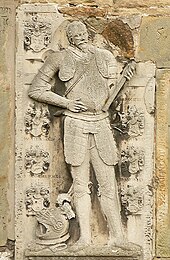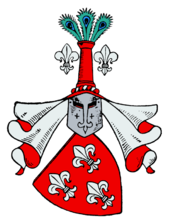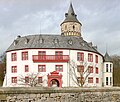Cramm
Cramm is the name of a Lower Saxon nobility family who later received the title of baron .
history
According to a source, the family came to the area of the Hildesheim diocese around 815 with the Carolingian Emperor Ludwig I and was loaned goods from him there. This thesis is controversial. The family's origin in the nearby village of Cramme in today's Wolfenbüttel district is also suspected.
The family first appeared in a document in 1150 with Dietrich von Cramme. The Cramm were a wealthy knight dynasty and respected feudal takers from the clergy and secular lords of the region of today's south-east Lower Saxony. In the Middle Ages , many descendants were knights or ministerials . In 1250 they became Truchsesse in the Duchy of Braunschweig-Lüneburg . In later centuries family members served the Guelph dukes and kings as generals, chamberlains and ministers.
Well-known namesake



- Armgard von Cramm (1883–1971), mother of Bernhard zur Lippe-Biesterfeld and grandmother of Beatrix von Oranien-Nassau , former Queen of the Netherlands
- Asche von Cramm (also Aschwin IV., Ascanius, Assa von Cramm), mercenary leader of the 16th century and friend of Martin Luther
- Berno von Cramm (* 1934), German actor and voice actor
- Burghard von Cramm (1874–1936), German manor owner and court official
- Burkhard von Cramm , Commander of the Teutonic Order in the Kommende Buro , 2nd half of the 17th century
- Burkhard VI. von Cramm († October 5, 1599), Landgrave Hessian governor of Upper Hesse in Marburg
- Christian Friedrich Adolf Burghard von Cramm-Burgdorf (1837–1913), German envoy and author
- Dagmar von Cramm (* 1955), German author and nutritionist
- Franz von Cramm (1610–1661), German court official
- Gottfried von Cramm (1909–1976), German tennis player
- Helga von Cramm (1840–1919), Swiss painter and graphic artist
- Ludewig von Cramm (1791–1858), Brunswick Chamberlain and Landdrost , President of the 2nd Chamber
- Ludolf von Cramme, mentioned in a document in 1246, with which the family line of the von Cramm family begins
- Wolfgang Friedrich Adolf von Cramm-Burchard (1812–1879)
coat of arms
The arms of the Uradelsfamilie of Cramm show typical time a reclined plate and the helmet ( helm ) often in side view.
Blazon of the family coat of arms: “In red three (2: 1) silver lilies . On the helmet with red and silver covers, a conical red column with three natural peacock feathers, each separated by a silver lily . "
Blazon of the knightly coat of arms : “Three silver lilies (2: 1) set in red. On the helmet with red and silver blankets a silver open flight with silver and red saxes . "
Blazon of the common coat of arms : “Three red lilies (2: 1) placed in silver. On the helmet with red and silver covers a red open flight with red and silver saxes. "
Possessions
The noble family had been co-owners since the 13th century (alongside the von Bortfeld lords ) and from the 17th century sole owners of their ancestral seat, Oelber Castle in Oelber on the white road , a district of Baddeckestedt in Lower Saxony.
Due to the marriage of Burghard von Cramm in 1905 to Jutta Countess von Steinberg , the last and universal heir of her line from old Hildesheim pen nobility, the extensive estates of this family fell to the Cramms, including Brüggen and Bodenburg. After the Second World War , her 7 sons divided up the property among themselves, as land reform with expropriation was feared; these included, in particular, Brüggen Castle and the manors Oelber, Bodenburg , Harbarnsen and Wispenstein (the latter two were later sold). Nettlingen Castle, which was only acquired in 1906, had already been sold again before the war. Oelber, Brüggen and Bodenburg are still inhabited by members of the family and are maintained with considerable effort.
Brüggen Castle
Sambleben Castle (1627–1898)
Others
The name "von Cramm" is also known for the wheat grain brand "von Cramm wheat brandy", which no longer exists. It has been made since 1750 on the estate in Harbarnsen, a part of the municipality of Lamspringe . After the Second World War, the von Crammsche distillery developed into one of the leading grain distilleries in Lower Saxony. The "Steinbock brand" comprised three bottlings, the golden-yellow 43er (43% alcohol by volume) in a bottle wrapped in raffia, the 38er and the 32er Doppelkorn, commonly known as the "Kutscherschluck". From 1984 only raw alcohol was produced and sales and the distilling rights were given to the Dethleffsen company in Flensburg. Later the operation in Harbarnsen was completely given up.
literature
- Genealogical handbook of the nobility , Adelslexikon Volume II, Volume 58 of the complete series, CA Starke Verlag, Limburg (Lahn) 1974, ISSN 0435-2408
Web links
Individual evidence
- ↑ General Teutsches Adels-Lexicon: Darinn von d. old u. new Gräfl.-Freyherrl.- u. Noble families ... is traded . Fuchs, 1774 ( google.de [accessed December 18, 2018]).
- ^ Document book of the Halberstadt Monastery, Volume I, No. 344
- ↑ Sambleben mansion in Schöppenstedt-Sambleben. Retrieved October 15, 2019 .








